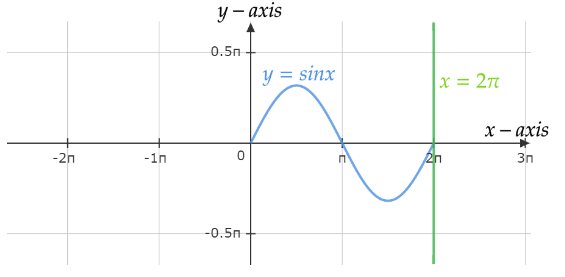
What is the area of the portion of the curve $y = \sin x$, lying $x = 0$, $y = 0$ and $x = 2\pi $?
A) $1$ square unit
B) $2$ square units
C) $4$ square units
D) $8$ square units
Answer
218.7k+ views
Hint: In this question, we are given the equation of the curve and the lines. We have to find the area bounded by them. Firstly, plot the graph of the following. Then, for the area integrate the equation of the curve with respect to $dx$ from $x = 0$ to $x = 2\pi $. Also, the area from $0$ to $\pi $ and $\pi $ to $2\pi $ is same. So, you can solve any of the integration part and then double it. Solve it further using integration and trigonometric formulas.
Formula Used:Integration formula –
$\int {\sin xdx = - \cos x + c} $
Trigonometric table values –
$\cos \pi = - 1$, $\cos {0^ \circ } = 1$
Complete step by step solution:Given that,
Equation of the curve is $y = \sin x$ and the line is $x = 2\pi $
Graph of the given equations is attached below (figure 1);

Figure 1: A graph containing the curve y=sin x and the line x=2𝜋
Now, as you can see the area of bounded region lies between $x = 0$ to $x = 2\pi $
So, integrate $y = \sin x$ with respect to $dx$ from $0$ to $2\pi $
Therefore, area will be $A = \int\limits_0^{2\pi } {\sin xdx} $
Now, the area is divided into two parts
So, $A = \int\limits_0^\pi {\sin xdx} + \int\limits_\pi ^{2\pi } {\sin xdx} $
As we know that, $\int\limits_0^\pi {\sin xdx} = \int\limits_\pi ^{2\pi } {\sin xdx} $
We can write the area as $A = 2\int\limits_0^\pi {\sin xdx} $
As we know that, integration of the function $\sin x$ is $ - \cos x + c$
It implies that,
$A = 2\left[ { - \cos x} \right]_0^\pi $
Now, resolving the limits we get
$A = 2\left[ { - \cos \pi + \cos 0} \right]$
$A = 2\left[ { - \left( { - 1} \right) + 1} \right]$
$A = 4$ square units
Option ‘C’ is correct
Note: Different methods are used to determine the area under the curve, with the antiderivative method being the most prevalent. The area under the curve can be calculated by knowing the curve's equation, borders, and the axis surrounding the curve. There exist formulas for obtaining the areas of regular shapes such as squares, rectangles, quadrilaterals, polygons, and circles, but no formula for finding the area under a curve. The integration procedure aids in solving the equation and determining the required area. Antiderivative methods are highly useful for determining the areas of irregular planar surfaces.
Formula Used:Integration formula –
$\int {\sin xdx = - \cos x + c} $
Trigonometric table values –
$\cos \pi = - 1$, $\cos {0^ \circ } = 1$
Complete step by step solution:Given that,
Equation of the curve is $y = \sin x$ and the line is $x = 2\pi $
Graph of the given equations is attached below (figure 1);

Figure 1: A graph containing the curve y=sin x and the line x=2𝜋
Now, as you can see the area of bounded region lies between $x = 0$ to $x = 2\pi $
So, integrate $y = \sin x$ with respect to $dx$ from $0$ to $2\pi $
Therefore, area will be $A = \int\limits_0^{2\pi } {\sin xdx} $
Now, the area is divided into two parts
So, $A = \int\limits_0^\pi {\sin xdx} + \int\limits_\pi ^{2\pi } {\sin xdx} $
As we know that, $\int\limits_0^\pi {\sin xdx} = \int\limits_\pi ^{2\pi } {\sin xdx} $
We can write the area as $A = 2\int\limits_0^\pi {\sin xdx} $
As we know that, integration of the function $\sin x$ is $ - \cos x + c$
It implies that,
$A = 2\left[ { - \cos x} \right]_0^\pi $
Now, resolving the limits we get
$A = 2\left[ { - \cos \pi + \cos 0} \right]$
$A = 2\left[ { - \left( { - 1} \right) + 1} \right]$
$A = 4$ square units
Option ‘C’ is correct
Note: Different methods are used to determine the area under the curve, with the antiderivative method being the most prevalent. The area under the curve can be calculated by knowing the curve's equation, borders, and the axis surrounding the curve. There exist formulas for obtaining the areas of regular shapes such as squares, rectangles, quadrilaterals, polygons, and circles, but no formula for finding the area under a curve. The integration procedure aids in solving the equation and determining the required area. Antiderivative methods are highly useful for determining the areas of irregular planar surfaces.
Recently Updated Pages
In a game two players A and B take turns in throwing class 12 maths JEE_Main

The number of ways in which 6 men and 5 women can dine class 12 maths JEE_Main

The area of an expanding rectangle is increasing at class 12 maths JEE_Main

If y xxx cdots infty then find dfracdydx A yxy 1 B class 12 maths JEE_Main

Chemical Properties of Hydrogen - Important Concepts for JEE Exam Preparation

JEE General Topics in Chemistry Important Concepts and Tips

Trending doubts
JEE Main 2026: Application Form Open, Exam Dates, Syllabus, Eligibility & Question Papers

Derivation of Equation of Trajectory Explained for Students

Hybridisation in Chemistry – Concept, Types & Applications

Understanding the Angle of Deviation in a Prism

Understanding Collisions: Types and Examples for Students

Understanding Atomic Structure for Beginners

Other Pages
JEE Advanced Marks vs Ranks 2025: Understanding Category-wise Qualifying Marks and Previous Year Cut-offs

How to Convert a Galvanometer into an Ammeter or Voltmeter

Understanding Centrifugal Force in Physics

JEE Main Marking Scheme 2026- Paper-Wise Marks Distribution and Negative Marking Details

Degree of Dissociation: Meaning, Formula, Calculation & Uses

Understanding Electromagnetic Waves and Their Importance




